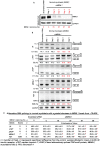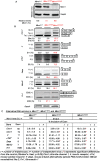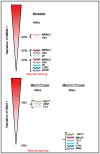RNA splicing is responsive to MBNL1 dose
- PMID: 23166594
- PMCID: PMC3499511
- DOI: 10.1371/journal.pone.0048825
RNA splicing is responsive to MBNL1 dose
Abstract
Myotonic dystrophy (DM1) is a highly variable, multi-system disorder resulting from the expansion of an untranslated CTG tract in DMPK. In DM1 expanded CUG repeat RNAs form hairpin secondary structures that bind and aberrantly sequester the RNA splice regulator, MBNL1. RNA splice defects resulting as a consequence of MBNL1 depletion have been shown to play a key role in the development of DM1 pathology. In patient populations, both the number and severity of DM1 symptoms increase broadly as a function of CTG tract length. However significant variability in the DM1 phenotype is observed in patients encoding similar CTG repeat numbers. Here we demonstrate that a gradual decrease in MBNL1 levels results both in the expansion of the repertoire of splice defects and an increase in the severity of the splice alterations. Thus, MBNL1 loss does not have an all or none outcome but rather shows a graded effect on the number and severity of the ensuing splice defects. Our results suggest that once a critical threshold is reached, relatively small dose variations of free MBNL1 levels, which may reflect modest changes in the size of the CUG tract or the extent of hairpin secondary structure formation, can significantly alter the number and severity of splice abnormalities and thus contribute to the phenotype variability observed in DM1 patients.
Conflict of interest statement
Figures





Similar articles
-
Cytoplasmic CUG RNA foci are insufficient to elicit key DM1 features.PLoS One. 2008;3(12):e3968. doi: 10.1371/journal.pone.0003968. Epub 2008 Dec 18. PLoS One. 2008. PMID: 19092997 Free PMC article.
-
(CTG)n repeat-mediated dysregulation of MBNL1 and MBNL2 expression during myogenesis in DM1 occurs already at the myoblast stage.PLoS One. 2019 May 22;14(5):e0217317. doi: 10.1371/journal.pone.0217317. eCollection 2019. PLoS One. 2019. PMID: 31116797 Free PMC article.
-
The CTG repeat expansion size correlates with the splicing defects observed in muscles from myotonic dystrophy type 1 patients.J Med Genet. 2008 Oct;45(10):639-46. doi: 10.1136/jmg.2008.058909. Epub 2008 Jul 8. J Med Genet. 2008. PMID: 18611984
-
Gain of RNA function in pathological cases: Focus on myotonic dystrophy.Biochimie. 2011 Nov;93(11):2006-12. doi: 10.1016/j.biochi.2011.06.028. Epub 2011 Jul 13. Biochimie. 2011. PMID: 21763392 Review.
-
Pathogenic mechanisms of myotonic dystrophy.Biochem Soc Trans. 2009 Dec;37(Pt 6):1281-6. doi: 10.1042/BST0371281. Biochem Soc Trans. 2009. PMID: 19909263 Free PMC article. Review.
Cited by
-
Dose-Dependent Regulation of Alternative Splicing by MBNL Proteins Reveals Biomarkers for Myotonic Dystrophy.PLoS Genet. 2016 Sep 28;12(9):e1006316. doi: 10.1371/journal.pgen.1006316. eCollection 2016 Sep. PLoS Genet. 2016. PMID: 27681373 Free PMC article.
-
Chronic exercise mitigates disease mechanisms and improves muscle function in myotonic dystrophy type 1 mice.J Physiol. 2019 Mar;597(5):1361-1381. doi: 10.1113/JP277123. Epub 2019 Jan 30. J Physiol. 2019. PMID: 30628727 Free PMC article.
-
Mechanisms of RNA-induced toxicity in CAG repeat disorders.Cell Death Dis. 2013 Aug 1;4(8):e752. doi: 10.1038/cddis.2013.276. Cell Death Dis. 2013. PMID: 23907466 Free PMC article. Review.
-
Selective and Reversible Ligand Assembly on the DNA and RNA Repeat Sequences in Myotonic Dystrophy.Chembiochem. 2022 Sep 5;23(17):e202200260. doi: 10.1002/cbic.202200260. Epub 2022 Jul 19. Chembiochem. 2022. PMID: 35790065 Free PMC article.
-
Brain pathology in myotonic dystrophy: when tauopathy meets spliceopathy and RNAopathy.Front Mol Neurosci. 2014 Jan 9;6:57. doi: 10.3389/fnmol.2013.00057. Front Mol Neurosci. 2014. PMID: 24409116 Free PMC article. Review.
References
-
- Harper PS, editor (2001) Myotonic Dystrophy. 3rd ed. Philadelphia: Saunders WB.
-
- Brook JD, McCurrach ME, Harley HG, Buckler AJ, Church D, et al. (1992) Molecular basis of myotonic dystrophy: expansion of a trinucleotide (CTG) repeat at the 3′ end of a transcript encoding a protein kinase family member. Cell 68: 799–808. - PubMed
-
- Harley HG, Rundle SA, Reardon W, Myring J, Crow S, et al. (1992) Unstable DNA sequence in myotonic dystrophy. Lancet 339: 1125–1128. - PubMed
-
- Napierala M, Krzyzosiak WJ (1997) CUG repeats present in myotonic kinase RNA form metastable slippery hairpins. J Biol Chem 272: 31079–31085. - PubMed
Publication types
MeSH terms
Substances
Grants and funding
LinkOut - more resources
Full Text Sources

